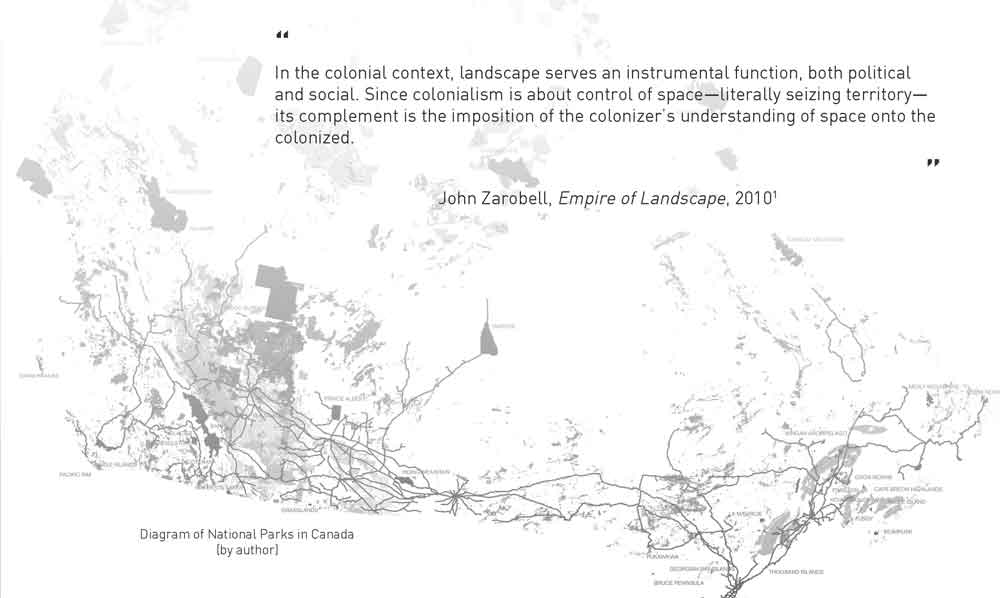
Report Cover Composite by Author / the underlying photograph of the woman and bear is from the Whyte Museum of the Canadian Rockies
Dispossession by Design: Recovering the role of landscape architects in the early colonial history of national parks in Canada
Tiffany Kaewen Dang, PhD Candidate, University of Cambridge, UK / Recipient of the Gunter Schoch Bursary /Grant: $6,000
EN_ National Parks hold iconic significance in the Canadian imagination as the proverbial ‘natural jewels’ of the nation. However, behind these important landscapes lies a dark history of colonization, beginning with the establishment of Banff National Park in 1885 and the subsequent displacement of the Stoney Nakoda First Nation. For over a century, the Canadian national parks system has been utilized as an instrument for colonizing the so-called ‘frontier,’ promoting through tourism and conservation, an imaginary vision of untamed wilderness; thereby implementing procedures of Indigenous erasure and cultural domination. Landscape architects have contributed to this national myth-building through the design of landscape projects within the national parks; the first Superintendent of Banff National Park, the first national park of Canada, was himself a landscape architect. Accordingly, this historical research allows for the interrogation of an alternate lineage of landscape architecture in Canada as having emerged from a geographical practice. This project aims to revisit the early history of the Canadian national parks system—as a continentally-scaled political tool of settler-colonialism and territorial assertion of settler-supremacy across the Canadian dominion—revealing its colonizing intent and dispossessive design through intersectional studies in geography, cartography, conservation, political theory, and landscape studies.
Update / Mises à jour
19.12.12 > Read LACF Final report _ Dispossession by Design by Tiffay Kaewen Dang
L’expropriation délibérée : Découvrir le rôle des architectes paysagistes au début de l’histoire coloniale des parcs nationaux du Canada
Tiffany Kaewen Dang, Candidate au Ph.D., Université de Cambridge, R.-U. Lauréate de la Bourse Günter A. Schoch / Bourse : 6000 $

National Parks in Canada / Author
FR_ Les parcs nationaux ont une importance emblématique dans l’imaginaire canadien en tant que « joyaux naturels » de la nation. Cependant, derrière ces grands paysages se cache une sombre histoire de colonisation, qui a débuté avec la création du parc national Banff en 1885 et le déplacement subséquent de la Première Nation Stoney Nakoda. Pendant plus d’un siècle, le réseau des parcs nationaux canadiens a été utilisé comme instrument pour coloniser ladite « frontière », soutenue par le tourisme et la conservation, une vision imaginaire d’une nature sauvage indomptable, mettant ainsi en œuvre des processus d’éradication et de domination culturelle des peuples autochtones.
Les architectes paysagistes ont contribué à bâtir ce mythe national par la conception de projets d’aménagement paysager dans les parcs nationaux; le premier directeur du parc national Banff, le premier parc national du Canada, était lui-même un architecte paysagiste. Conséquemment, cette recherche historique permet de s’interroger sur une pratique alternative de l’architecture de paysage au Canada issue d’une pratique géographique. Ce projet réexamine les débuts du réseau des parcs nationaux canadiens – en tant qu’outil politique à l’échelle continentale du colonialisme et de l’affirmation de la suprématie des colons sur l’ensemble du territoire du dominion canadien – en révélant ses intentions colonialistes et l’expropriation délibérée au moyen d’études intersectionnelles en géographie, en cartographie, en conservation, en théorie politique et en études des paysages.
